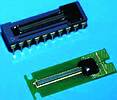

There is no doubt that the adoption of fingerprint-identification technology will have many advantages and significant impact on our daily lives.
Each human fingerprint has its own unique characteristics enabling this technology to be potentially used in a number of different applications that include PDAs, mobile devices, keyless systems, computers, and physical access for buildings, homes, vehicles, etc.
Fingerprint sensors are very small and very easy to use. You do not have a problem with someone forgetting their password or losing their IC card. Your fingers are always with you and the fingerprint has long been accepted as a secure standard of people-recognition and authentication.
Fingerprint analysis technology consists of different steps: image acquisition; extraction of the finger print data; template storage.

Image acquisition
There are different kinds of sensors available on the market based on different technologies.
* Capacitive sensors: This technology usually consists of an array of capacitor electrodes where the sensors measure the capacitance between an array of plates formed on the silicon surface, and the skin contacting the surface of the sensor directly above it. When a finger presses on the sensor it creates varying capacitance across the chip corresponding to the ridges and troughs of the fingerprint. The rate of change of the potential (voltage) on the capacitor plate is proportional to the capacitance seen by the capacitor plate, through the relation: iref = Cdv/dt
A pixel that is under a fingerprint ridge discharges slowly, and vice-versa, a pixel under a fingerprint trough discharges rapidly. This difference in the discharge rate is detected through sample/hold circuitry and converted to a 256-bit grey scale output. In this manner, fingerprint images can be detected.
Capacitive sensors are supplied, for example, from Fujitsu. It offers two kinds of sensor, the single-touch sensor the MBF200, and the 'swipe' sensor the MBF310 - both capacitive solid-state devices with 500 dpi resolution (50 µm pitch). The MBF200 has 12,8 x 15,0 mm sensor area and the MBF310 a 16,1 x 6,5 mm sensor area. The MBF200 has one of three bus interfaces: 8-bit microprocessor bus interface; integrated USB full-speed interface; or integrated serial peripheral interface. The MBF310 has one of two bus interfaces: 8-bit microprocessor bus interface; or integrated serial peripheral interface.
* Thermal sensors: Thermal sensors use a layout similar to those of capacitive types, but they measure the temperature differential between the sensor pixels that are in contact with the ridges, and those under the troughs that are not in contact. There is, therefore, a detectable temperature difference to map the fingerprint pattern.
Thermal sensors are supplied, for example, from Atmel, ie, its FingerChip series, the AT77C101B, AT77C104B and FCD4B14, all 500 dpi resolution with 50 x 50 µm pixel pitch. Image zones are: 0,4 x 14 mm, image array 8 x 280 (2240 pixels) for AT77C101B; 0,4 x 11,6 mm, image array 8 x 232 (1856 pixels) for AT77C104B; image zone 0,4 x 14 mm, image array 8 x 280 (2240 pixels) for FCD4B14.
Extracting the fingerprint data
Usually this function is performed by the software. There are different kinds of software available on the market that digitise the image and create a template of data, or minutia, unique to the fingerprint. The size of these templates are generally 200 to 400 bytes, corresponding to a map of around 20 minutiae points, but in certain cases where more minutiae points are required to achieve an effective fingerprint capture, the size is around 1,5 KB. The system tests for matches between the extracted minutia template and a candidate template. A common method of gauging the quality of the algorithm itself is through the well-known FAR (false accept rates) and FRR (false reject rates) figure, but in any case, this figure should be carefully considered before judging the quality of the algorithm.
Template storage
The most common way to store the different templates in an embedded system is by using a flash memory device. The quantity of template stored is dependent of course, on the size of the template data and the size of the flash memory. In some cases the template storage is managed from an external database.
Final considerations
The market has considerable expectations for this system, and in principle we can say that the system should be reliable and robust, which means the sensor must be very highly protected in terms of surface coatings, resistance versus abrasion, scratch and chemical agent level and ESD (electrostatic discharge).
The algorithm should work for everyone in a consistent way, this means with very high efficiency and reliability and with a very good FAR/FRR figure. This is really important since there are some people from whom it can be very difficult to capture a fingerprint image (for example, people that practice extreme sports like free-climbing) because the fingerprint pattern could be damaged. Even so, the end-user cannot accept mistakes or failures.
The system should be able to work in combination with different standards, for example in an environment such as smartcard readers where a standard format might be necessary. This could include an encryption system (for example 3DES), which should be easily connected to another piece of equipment like an add-on board. In practice the end-user expects a very highly secure system. The security element should not only be related to the application itself but also the template information that is stored. It should also, of course, be very easy to use and be available at a reasonable price.
In recent years fingerprint sensing technology has made some advancement and is now mature enough to start growing in volume for a number of different applications.
| Tel: | +27 11 236 1900 |
| Email: | [email protected] |
| www: | www.ebv.com |
| Articles: | More information and articles about EBV Electrolink |

© Technews Publishing (Pty) Ltd | All Rights Reserved